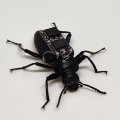Humans may be inadvertently helping to spread a deadly fungus that is killing green tree frogs and other native frog species at an alarming rate, according to researchers at The University of Queensland.
Dr Pearl Symonds from UQ’s School of Veterinary Science said the fungus, known as ‘frog chytrid’, was found in a very high percentage of dying frogs and had somehow been transferred to a large number of areas around Australia.
“One of the reasons that this fungus can spread so rapidly is a result of human activity”, she said.
“People, children in particular, should really avoid catching or exchanging tadpoles or frogs. Research suggests that the fungus is transferred directly between tadpoles and frogs and possibly through exposure to infected water.
“It is very important not to move the amphibians from one area to another, as it may introduce the fungus to a previously uncontaminated environment.
“Wet mud on boots and tyres, wet fishing, camping, gardening or equipment may also be helping to spread the disease.”
Dr Symonds said the chytrid did not appear to affect the ever-resilient cane toads, but it attacked parts of a frog`s skin that contained keratin (a type of protein).
“Frogs use their skin in respiration, so when the skin is infected, it makes it difficult for the frogs to breathe. The behaviour of the sick frog changes and they are often seen out in the daytime when they are normally hidden," she said.
“The disease does not always kill frogs immediately. They can swim or hop to other areas before they die, spreading the fungal spores to new ponds and streams.”
UQ researchers are studying ‘frog chytrid’ in a bid to determine how and why such a deadly disease emerged unexpectedly. It is hoped that extensive research may help to prevent the circumstance that created the disease, from occurring again.
Dr Symonds said there were also other factors contributing to the decline in the frog population including climate change and the loss of natural habitats caused by increased urban development.
For more information: Tiffany Lippett at the Office of Marketing and Communications – 07 3365 2049 or t.lippett@uq.edu.au
INFORMATION FACT SHEET*
How to help stop the spread of frog chytrid fungus:
Please observe the following precautions if you intend to visit a natural frog habitat such as a pond, mountain stream, rainforest, park or garden.
• Only touch frogs when absolutely necessary. Remember to use disposable gloves, sample bags and sterile equipment.
• Clean and dry all equipment and wet or muddy footwear before and between visiting frog sites. This may include cleaning the tyres of your vehicle before visiting known high-risk sites where threatened frog species may live.
• Never, ever move a frog from one area to another.
• Carry cleaning utensils and a disinfectant for use between sites.
• Drying and heating (50 oc) equipment can be a non toxic option for killing the fungus.
Warning signs that a frog may be sick. It may:
• have discoloured skin;
• be sloughing, or peeling, on the outside layers of its skin. This can vary from obvious peeling of skin (particularly on the feet), to a roughness of the frog`s skin that you can barely see;
• sit out in the open, not protecting itself by hiding;
• be sluggish, and have no appetite;
• have its legs spread slightly away from itself, rather than keeping them tucked close to its body. In more extreme cases, the frog’s body will be rigid and its back legs will trail behind it.
What do to if you find a sick frog:
Some of the symptoms of Chytrid fungal infections are described above. If you think you`ve found a sick frog please follow the steps below:
• Place the frog into a container without directly touching it.
• Make sure the container is escape-proof and has a few small air holes and a small amount of water.
• Contact the Queensland Frog Society (www.qldfrogs.asn.au) for a list of frog coordinators in your area who will be able to provide assistance and advice.
*Information provided by the National Parks and Wildlife Service and the Queensland Frog Society
.jpg)


